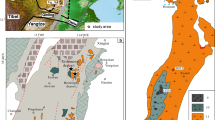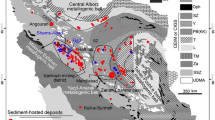Abstract
The Mianeh iron skarn deposit lies in the Arasbaran region within the Qaradagh metallogenic district, NW Iran. This high-grade massive magnetite skarn originated by the interaction of Upper Cretaceous limestone with metasomatic ore-bearing fluids associated with hypabyssal Oligo-Miocene quartz diorite. Mineral chemistry of the primary clinopyroxenes demonstrates the sub-alkaline, volcanic arc setting of magmatism. Two general stages of skarnification are recognized: (1) silicate skarn (stage I) is composed essentially of grossular and low-Fe diopside formed before the main mineralization and (2) magnetite-garnet skarn (stage II) composed of strongly anisotropic coarse-grained garnets with a narrow compositional zoning radially formed by addictive infiltrating of silica and iron-rich metasomatic fluids which overprint and/or crosscut the early stage silicate skarn. Anhydrous prograde calc-silicate assemblages were replaced by a series of hydrous calc-silicates (epidote, tremolite-actinolite) and/or quartz, calcite, magnetite, hematite, and pyrite. Magnetite (±hematite) is the dominant hypogene ore mineral that initially precipitated coincident with the late prograde to the early retrograde metasomatic stages. Mineralogical studies suggest that silicate skarn formation commenced at temperatures about 560 °C, X(CO2)fluid ≤ 0.15, αSiO2∼−1.0, and fluid pressure 1.0 kbar. The magnetite-garnet skarn formed from H2O-rich fluids [X(CO2)fluid < 0.1] at a temperature of 525 to 450 °C and maximum log ƒO2 between −20.2 and −23. During the late stages of prograde skarn development, the stability field of andradite shifted to low ƒO2 and ƒS2 conditions resulting in main iron ore deposition (as magnetite). The andradite replacement temperature and presence of pyrite (instead of pyrrhotite) suggest that logƒS2 remained constant at about −6 to −7 during cooling of the system.












Similar content being viewed by others
References
Aghanabati A (2004) Geology of Iran: Geological Survey of Iran
Aghazadeh M, Castro A, Badrzadeh Z, Vogt K 2011. Post-collisional polycyclic plutonism from the Zagros hinterland: the Shaivar Dagh plutonic complex, Alborz belt, Iran. Geological Magazine Cambridge University Press, pp 1–29
Amelia M, Logan MA (2000) Mineralogy and geochemistry of the Gualil’an skarn deposit in the Precordillera of western Argentina. Ore Geol Rev 17:113–138
Aminifazl A (1994) Study of petrology, mineralogy and geochemistry of Qara-Dagh pluton (Ordubad granite), NW Iran. [Ph.D thesis], Science academy of Azerbaijan, Azerbaijan Republic
Atkinson WW, Einaudi MT (1978) Skarn formation and mineralization in the contact aureole at Carr Fork, Bingham, Utah. Econ Geol 73:1326–1365
Baghban S, Hosseinzadeh MR, Moayyed M, Mokhtari MA, Gregory D (2015) Geology, mineral chemistry and formation conditions of calc-silicate minerals of Astamal Fe-LREE distal skarn deposit, Eastern Azarbaijan Province, NW Iran. Ore Geol Rev 68:79–96
Beddoe-Stephens B, Shepherd TJ, Bowles JFW, Brook M (1987) Gold mineralization and skarn development near Muara Sipongi, West Sumatra, Indonesia. Econ Geol 82:1732–1749
Berman RG, Brown TH, Greenwood HJ (1985) An internally consistent thermodynamic data base for minerals in the system Na2O-K2O-CaO-MgO-FeO-SiO2-Al2O3-Fe2O3-TiO2-H2O-CO2. Atomic Energy of Canada Technical Report TR-337, 62 p
Bonev N, Stampfli G (2009) Gabbro, plagiogranite and associated dykes in the supra-subduction zone, Evros ophiolites, NE Greece. Geol Mag 146:72–91
Bowers TS, Helgeson HC (1983) Calculation of the thermodynamic and geochemical consequences of nonideal mixing in the system H2O-CO2-NaCl on phase relations in geologic systems: equation of state for H2O-CO2-NaCI fluids at high pressures and temperatures. Geochim Cosmochim Acta 41:1247–1275
Calagari AA (2004) Fluid inclusion studies in quartz veinlets in the porphyry copper deposit at Sungun, east-Azarbaidjan, Iran. J Asian Earth Sci 23:179–189
Choo CO (2002) Complex compositional zoning in epidote from rhyodacitic tuff, Bobae sericite deposit, southeastern Korea. N Jb Mineral 177:181–197
Chowdhury S, Lentz DR (2011) Mineralogical and geochemical characteristics of scheelite-bearing skarns, and genetic relations between skarn mineralization and petrogenesis of the associated granitoid pluton at Sargipali, Sundergarh District, Eastern India. J Geochem Explor 108:39–61
Ciobanu CL, Cook NJ (2004) Skarn textures and a case study: the Ocna de Fier-Dognecea orefield, Banat, Romania. Ore Geol Rev 24:315–370
Deer WA, Howie RA, Zussman J (1992) An introduction to the rock forming minerals. Second edition. Longman Scientific and Technical, 696 p
Dilek Y, Imamverdiyev N, Altunkaynak S (2010) Geochemistry and tectonics of Cenozoic volcanism in the Lesser Caucasus (Azerbaijan) and the peri-Arabian region: collision-induced mantle dynamics and its magmatic fingerprint. Int Geol Rev 52:536–578
Ebrahimi S, Pan Y, Alirezaei S, Mehrparto M (2006) Sharafabad quartz-gold vein system, NW Iran. Geological Association of Canada-Mineralogical Association of Canada, Montreal, Canada
Einaudi MT (1982a) Description of skarns associated with porphyry copper plutons. Advances in geology of porphyry copper deposits. S. W. North America, pp 139–183
Einaudi MT, Meinert LD, Newberry RJ (1981) Skarn deposits. Economic Geology 75th Anniv, pp 317–391
Franz G, Liebscher A (2004) Physical and chemical properties of the epidote minerals-an introduction. In: Franz G, Liebscher A (eds) Epidotes. Rev Mineral Geochem 56, pp 1–82
Guy B (1993) Mathematical revision of Korzhinskii’s theory of infiltration metasomatic zoning. Eur J Mineral 5:317–339
Hassanpour S, Alirezaei S (2014) SHRIMP zircon U–Pb and biotite and hornblende Ar–Ar geochronology of Sungun, Haftcheshmeh, Kighal, and Niaz porphyry Cu–Mo systems: evidence for an early Miocene porphyry-style mineralization in northwest Iran. Int J Earth Sci 104:45–59
Hawkins T, Smith MP, Herington RJ, Maslennikov V, Boyce AJ, Jeffries T (2015) The geology and genesis of the iron skarns of the turgai belt, northwestern Kazakhstan. Ore Geology Reviews (published online)
Jamali H, Mehrabi B (2015) Relationships between arc maturity and Cu-Mo-Au porphyry and related epithermal mineralization at the Cenozoic Arasbaran Magmatic Belt. Ore Geol Rev 65:487–501
Jamali H, Dilek Y, Daliran F, Yaghubpur AM, Mehrabi B (2010) Metallogeny and tectonic evolution of the Cenozoic Ahar–Arasbaran volcanic belt, northern Iran. Int Geol Rev 52:608–630
Jamali H, Yaghubpur A, Mehrabid B, Dilek Y, Daliran F, Meshkani SA (2012) Petrogenesis and tectono-magmatic setting of Meso-Cenozoic magmatism in Azerbaijan province. Northwestern Iran Petrol Croat:39–56
Jamtveit B, Wolgelius RA, Fraser DG (1993) Zoning patterns of skarn garnets: records of hydrothermal system evolution. Geology 21:113–116
Karimzadeh Somarin A (2004) Garnet composition as an indicator of Cu mineralization: evidence from skarn deposits of NW Iran. J Geochem Explor 81:47–57
Karimzadeh Somarin A (2010) Garnetization, a ground preparation process for ore mineralization: evidence from the Mazraeh skarn deposit, NW Iran. International Journal of Earth Sciences 99:343–356
Karimzadeh Somarin A, Moayyed M (2002) Granite- and gabbrodiorite-associated skarn deposits of NW Iran. Ore Geol Rev 20:127–138
Lentz DR, Walker JA, Stirling JAR (1995) Millstream Cu-Fe skarn deposit: an example of a Cu-bearing magnetite-rich skarn system in northern New Brunswick. Explor Min Geol 4:15–31
Leterrier J, Maury RC, Thonon P, Girard D, Marchal M (1982) Clinopyroxene composition as a method of identification of the magmatic affinities of paleo-volcanic serie. Earth Planet Sci Lett 59:139–154
Mehrpartou M (1993) Geological Map of Syahroud (1:100000). Geological Survey of Iran
Meinert LD (1992) Skarns and skarn deposits. Geosciences Canada Reprint Series 6, pp 117–134
Meinert LD (1997) Application of skarn deposit zonation models to mineral exploration. Explor Min Geol 6:185–208
Moayed M (2002) Petrological investigations of Western Alborz-Azarbaijan volcano-plutonic belt pointed to Hashtjin district [PhD thesis]. University of Saheed-Beheshti 328 (in Persian)
Mokhtari MAA (2012) The mineralogy and petrology of Pahnavar Fe skarn in the Eastern Azarbaijan, NW Iran. Cent Eur J Geol 4:578–591
Mokhtari MAA, Moein-Vaziri H, Gorbani MR, Mehrpartou M (2014) Geology and geochemistry of Aniq-Qarachilar Au–Cu–Mo mineralization (NE of Kharvana, Eastern Azarbaijan). Q J Geosci Geol Surv Iran 90:135–150 (in Persian)
Mollai H, Pe-Piper G, Dabiri R (2014) Genetic relationships between skarn ore deposits and magmatic activity in the Ahar region, western Alborz, NW Iran: evidence for metasomatism and copper mineralization. Geol Carpath 65:207–225
Morimoto N (1989) Nomenclature of pyroxenes. Can Mineral 27:143–156
Nabavi M (1976) An Introduction to the Geology of Iran. Geological Survey of Iran Publication, 109 p (in Persian)
Nisbet GE, Pearce JA (1977) Clinopyroxene composition in mafic lavas from different tectonic settings. Contrib Mineral Petrol 63:149–160
Pang KN, Chung SL, Zarrinkoub MH, Lin YC, Lee HY, Lo CH, Khatib MM (2013) Iranian ultrapotassic volcanism at ∼11 Ma signifies the initiation of postcollisional magmatism in the Arabia-Eurasia collision zone. Terra Nova 25:405–413
Perkins EH, Brown TH, Berman RG (1986) PTX-SYSTEM: three programs for calculation of P-T composition phase diagrams. Comput Geosci 12:749–755
Putnis A, Austrheim H (2010) Fluid induced processes: metasomatism and metamorphism. Geofluids 10:254–269
Shvarov YV, Bastrakov EN (1999) HCh: a software package for geochemical equilibrium modelling. User’s Guide. Aust. Geol. Surv. Organization, Record 25
Slaughter J, Kerrick DM, Wall VJ (1975) Experimental and thermodynamic study of equilibria in the system CaO-MgO-SiO2-H20-CO2. Am J Sci 275:143–I62
Taylor BE, Liou JG (1978) The low-temperature stability of andradite in C–O–H fluids. Am Mineral 63:378–393
Whitney DL, Evans BW (2010) Abbreviations for names of rock-forming minerals. Am Mineral 95:185–187
Yoder HS, Titley CE (1962) Origin of basalt magmas: an experimental study of natural and synthetic rock systems. J Petrol 3:342–532
Acknowledgements
The laboratory studies for this contribution were carried out at the Institute of Mineralogy and Economic Geology, RWTH University, Germany. My grateful appreciation is extended to R. Klinghardt for his assistance in electron microprobe analyses. The author also wishes to thank Prof. Ali Asghar Calagari for his thoughtful and insightful opinions regarding the study of skarn mineralization in this area.
Author information
Authors and Affiliations
Corresponding author
Rights and permissions
About this article
Cite this article
Siahcheshm, K. Mineralogy and metasomatic evolution of the Mianeh iron skarn deposit, Norduz-Agarak border, NW Iran. Arab J Geosci 10, 309 (2017). https://doi.org/10.1007/s12517-017-3084-z
Received:
Accepted:
Published:
DOI: https://doi.org/10.1007/s12517-017-3084-z




